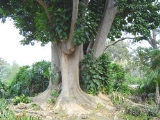
Ombú
Encyclopedia
- For the Tibetan village see Ombu, TibetOmbu, TibetNot to be confused with Ombú, a tree native to South AmericaOmbu is a village in the Tibet Autonomous Region of China....
Phytolacca dioica, commonly known as ombú, is a massive evergreen herb
Herb
Except in botanical usage, an herb is "any plant with leaves, seeds, or flowers used for flavoring, food, medicine, or perfume" or "a part of such a plant as used in cooking"...
native to the Pampa
Pampa
The Pampas are the fertile South American lowlands, covering more than , that include the Argentine provinces of Buenos Aires, La Pampa, Santa Fe, Entre Ríos and Córdoba, most of Uruguay, and the southernmost Brazilian State, Rio Grande do Sul...
of South America
South America
South America is a continent situated in the Western Hemisphere, mostly in the Southern Hemisphere, with a relatively small portion in the Northern Hemisphere. The continent is also considered a subcontinent of the Americas. It is bordered on the west by the Pacific Ocean and on the north and east...
. The bush has an umbrella-like canopy
Canopy (forest)
In biology, the canopy is the aboveground portion of a plant community or crop, formed by plant crowns.For forests, canopy also refers to the upper layer or habitat zone, formed by mature tree crowns and including other biological organisms .Sometimes the term canopy is used to refer to the extent...
that spreads to a girth of 12 to 15 meters (40 to 50 feet) and can attain a height of 12 to 18 meters (40 to 60 feet). The ombú grows fast but being herbaceous its wood is soft and spongy enough to be cut with a knife. Because of this, it is also used in the art of bonsai
Bonsai
is a Japanese art form using miniature trees grown in containers. Similar practices exist in other cultures, including the Chinese tradition of penjing from which the art originated, and the miniature living landscapes of Vietnamese hòn non bộ...
, as it is easily manipulated to create the desired effect. Since the sap is poisonous, the ombú is not grazed by cattle and is immune to locusts and other pests. For similar reasons, the leaves are sometimes used as a laxative or purgant. It is a symbol of Uruguay
Uruguay
Uruguay ,officially the Oriental Republic of Uruguay,sometimes the Eastern Republic of Uruguay; ) is a country in the southeastern part of South America. It is home to some 3.5 million people, of whom 1.8 million live in the capital Montevideo and its metropolitan area...
and Argentina
Argentina
Argentina , officially the Argentine Republic , is the second largest country in South America by land area, after Brazil. It is constituted as a federation of 23 provinces and an autonomous city, Buenos Aires...
, and of Gaucho
Gaucho
Gaucho is a term commonly used to describe residents of the South American pampas, chacos, or Patagonian grasslands, found principally in parts of Argentina, Uruguay, Southern Chile, and Southern Brazil...
culture, as its canopy is quite distinguishable from afar and provides comfort and shelter from sun and rain. The fireproof trunk also stores water for the large fires. The leaves may have a low flash point
Flash point
The flash point of a volatile material is the lowest temperature at which it can vaporize to form an ignitable mixture in air. Measuring a flash point requires an ignition source...
, though, as dramatised in In Search of the Castaways
In Search of the Castaways
In Search of the Castaways is a novel by the French writer Jules Verne, published in 1867–1868. The original edition, published by Hetzel, contains a number of illustrations by Édouard Riou. In 1876 it was republished by George Routledge & Sons as a three volume set titled "A Voyage Round The World"...
.
The herb is categorized in the same genus as the North America
North America
North America is a continent wholly within the Northern Hemisphere and almost wholly within the Western Hemisphere. It is also considered a northern subcontinent of the Americas...
n pokeweed
Pokeweed
The pokeweeds, also known as pokebush, pokeberry, pokeroot, poke sallet, polk salad, polk salat, polk sallet, inkberry or ombú, comprise the genus Phytolacca, perennial plants native to North America, South America, East Asia and New Zealand...
. The species is also cultivated in Southern California
Southern California
Southern California is a megaregion, or megapolitan area, in the southern area of the U.S. state of California. Large urban areas include Greater Los Angeles and Greater San Diego. The urban area stretches along the coast from Ventura through the Southland and Inland Empire to San Diego...
as a shade tree.

